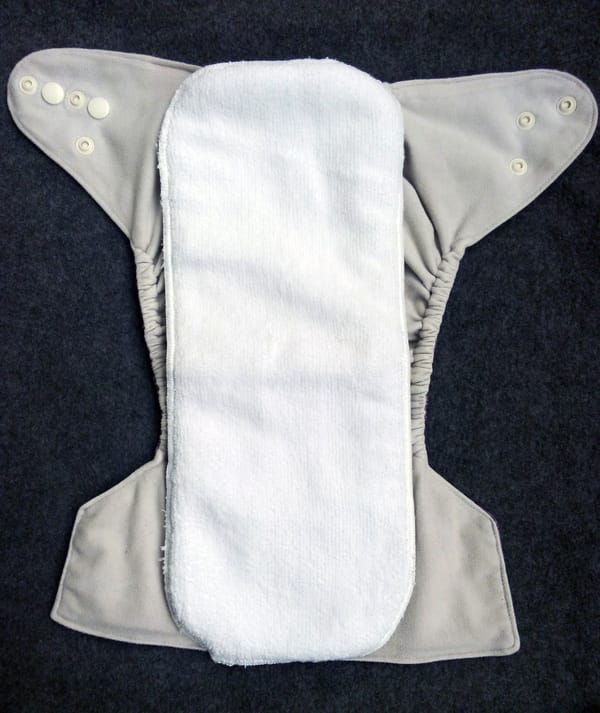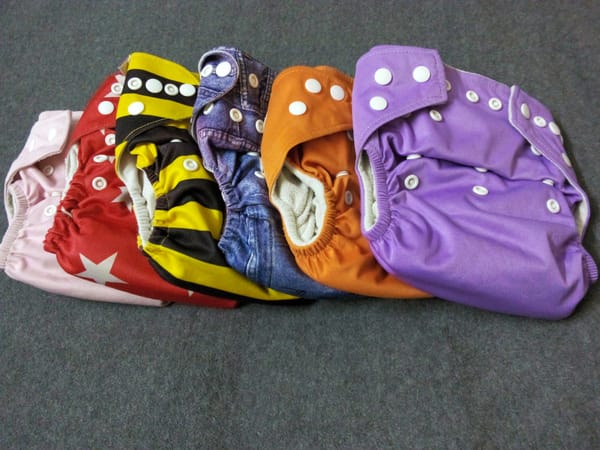Even after constant monitoring from the High Court and many orders in place, managing waste the right way still continues to be a major issue in Bengaluru. Disposable diapers occupy a major share of the crisis.
The solution doesn’t lie in leaving your kids run around naked, not for the busy and indulgent mom of today. This is where modern cloth diapers come into the picture.
“What, cloth diapers? No…!” is what we hear, even from the environmentally conscious citizens of Bangalore, who otherwise try to do their bit. Many others who would want to minimise the expenses of diapers would not know of a cheaper and cleaner alternative for disposable diapers. If you belong to any of these categories, this is for you.

Your baby will be comfortable in cloth diapers. Pic: Sowrabha Karinje
What exactly is a modern cloth diaper?
In the West, there are different variations of cloth diapers available. India is slowly being exposed to the comfortable variants. The popular ones are the pocket diapers, with an outer waterproof cover and an inner absorbent washable insert (majorly made of microfiber or bamboo). The insert is stuffed into the pocket of the cover. The part that touches the baby’s skin is made up of a stay-dry material like microfleece or suede.
There are also waterproof covers available from various brands like Bumchum, Flip, Bumberry etc. and these can be used with a piece of cotton cloth folded or an insert made up of natural material like bamboo.
These cloth diapers can be easily washed using a washing machine. So, all in all this is as good as a disposable diaper, but can be reused.
Wet bags are available for carrying the used diapers when on the move. Pail liners are available for storing them until they reach the washing machine.
Why cloth diaper?
Cost effective: A single disposable diaper costs anywhere between Rs.9 to Rs.15, and each day atleast 6-7 diapers are required. That makes it at least a Rs 60-100 per day and Rs 1800-3000 per month. Say your kid takes two years to be potty-trained, math done; it digs a significantly big hole in your pocket.
The cost of a single cloth diaper starts from Rs.350. (Of course the imported big branded ones will cost more, and can be done without). Around 10-12 of these might suffice if the wash is done every day. Each diaper with a single insert can stay dry for almost 3 hrs (depends on the individual baby, though). You can stuff two inserts for overnight purpose. There are snap buttons/velcro tapes that help in resizing the diaper, so the diaper adjusts with the growing size of the kid. If properly taken care of, they work for your second kid as well!! Initial investment is comparatively on a higher side, but in the long run there will be a lot of savings.
Chemical-free: Disposable diapers are known to contain harmful chemicals like traces of Dioxin, Tributyl-tin (TBT), sodium polyacrylate etc. that can cause damaged immunity, developmental delays, hormone interference, certain types of cancers, increase in scrotal temperature in boys causing an intrusion in the physiological testicular cooling mechanism, that is important for normal spermatogenesis. But the cloth diapers are free from all these.
Greener Earth: Even if we keep the diapers required at a conservative 6 per day, roughly estimated, a child requires close to 6,000 diapers for two years. As we know, plastic in the disposable diapers and other elements take about 250-500 years for decomposing – long after our children, grandchildren and great, great, great grandchildren will be gone.
It is suggested that feces be flushed down the toilet before disposing a disposable diaper, but God knows how many of us follow it in reality. This human feces can leach and cause contamination or spread communicable diseases when disposed of in the landfills. They can be a breeding ground for a wide variety of viruses, posing a serious danger to human health. By going for cloth diapers, all these issues can be avoided.
Pocket cloth diapers, with snaps/buttons to adjust as the baby grows up. Pic: Sowrabha Karinje
Why modern cloth diapers are better than the traditional ones?
Cloth diaper is not a totally new concept to India, it is just a new avatar, which is very convenient and cool. We used to have soft “dhothi” pieces or muslin clothes tied around the kid and reused post-washing. The cloth was bigger and not leakproof and that could be a problem for today’s super-busy mom.
The snug fit that a modern cloth diaper gives your baby is as good as the disposables; hence the mess is less, with no leakages. Modern cloth diapers can be adjusted to the size of the baby, and in effect the trouble is that much less. The stay-dry options are preferred by many parents for health and/or comfort reasons. Modern cloth diapers come in various colors and prints and are very presentable even for outdoors.
Do’s and don’ts for cloth diapers
- Wash a new cloth diaper and inserts before use, to ensure it is clean and bacteria-free.
- Flush the poop down the toilet basin as soon as you remove it. You can either spray the insert with health faucet, or simply pour water from a mug.
- Then soak it for half an hour, to remove the residues. This also helps in removing stains. Little normal detergent powder would do good.
- Pour the water used for soaking into toilet.
- The diaper, once rinsed, is good to go to washing machine with you other laundry. Check the washing instructions if any, on the diaper, and set the temperature of the washing machine accordingly.
- Close velcro buttons if any, before putting it into washing machine.
- Dry it in the sun.
- Have a stock of diapers. Even if it looks expensive, it is only one-time, and saves you in the long run.
 Diaper’s inside, with the washable insert. Pic: Sowrabha Karinje
Diaper’s inside, with the washable insert. Pic: Sowrabha Karinje
Tried and tested method
On a personal note, I have been mostly using pocket diapers and also a few covers with cotton flats/bamboo inserts for my 15-month-old daughter. She has been wearing them since last one year and I see that the quality of the diapers still remains very good.
The elastic helps the diaper remain in the right position. I have a stash of 14 diapers, and I do my laundry on the washing machine almost everyday. I spray the diaper with the toilet health faucet and its all clean to go to the machine.
There are several mommies who use disposable liners to skip this step. However, I did not find that necessary. I dry them out in sun and they are stain-free. I am not specific about the detergent as long as I ensure to use a lesser quantity.
I have used cloth diapers even while travelling for short distances; I just had to bring them back home for washing. There has not been a single incident of diaper rash so far, and only a couple of leakage incidents (that happened when I missed changing them on time). So we are a happy mom-daughter!!
Where to find modern cloth diapers?
The list of some of the places to buy:
- US-based Cotton Babies — BumGenius and Flip Diapers — marketed in India by Smart Baby Retail. You can order online through http://www.smartbaby.in/
- The ones that are making a mark in the Indian market like Bumchum – http://www.bumchumdiapers.com
- Facebook businesses like “Cloth Diaper Shop-India” continue to help newbie parents with their products. You can place orders through https://www.facebook.com/clothdiapershop.in or http://clothdiapershopindia.blogspot.in
- There are several more brands which can be procured through http://www.amazon.in /http://www.ebay.in or babyshop websites like http://www.firstcry.com through a simple search for the term Reusable cloth diapers.
These modern cloth diapers are not yet a popular selling product on retail shops. However we can find them at some stores like AppleofmyI.
If you decide to cut the cost, just buy a cloth diaper, and get the same thing stitched by your local tailor in bulk. That will even reduce your carbon footprint! Extra inserts can also be stitched, if you have pocket diapers and not enough inserts.
Prefolds, flats with snappis, Stay-dry liners etc. which can be used with suitable covers are available in the market. Permutations and combinations are many, if you have a heart for it. The market for cloth diapers is increasing with the growing awareness and an urge to do something for the planet earth.
So let us go green with cloth diapers!
Related Articles
Menstrual hygiene is not about sanitary napkins
The basics of babyproofing
How to take your child to work and other life lessons
Eco-friendly and traditional toys for children
How to calm your child by being silent
How to keep your children grounded


Nice article Sowrabha akka. I had no idea that cloth diapers existed. I hope more and more people start using it for the reasons you’ve mentioned.
And yeah, congratulations on the baby. She’s very cute. 🙂
Amazing stuff. Absolutely appropriate. Young moms out there, here is your chance to show your love for MOTHER EARTH.